#i still haven’t learned how to draw a flintlock
Text
GreedFall: Tips + My Review

So I picked up this game out of curiosity because I’m currently working on an RPG style historical fantasy that draws inspiration from a similar time period. I wanted to see how someone else handled the ‘flintlock’ genre and told a story with elements of this era. I am in no means a pro game reviewer but I completed the entire game yesterday and I have a lot I want to say.
There are some spoilers in this, so if you’d like to avoid reading them, don’t read the "Story” section.
Tips:
Do your companion quests early and as soon as they pop up. There are some incredible lore bits and development of your character as well as your companions within them. Also if you sideline a companion for too long, they might leave your party in ways that might surprise or unsurprise you.
Certain dialog options will give you more quest content. For example, you’ve caught a criminal and you are given the choice to kill them on the spot, or capture them for trial. If you kill them, your quest line ends there. If you decide to trial them, another quest line opens up and you get a lot more flavor.
You can essentially just follow the main quest line if you want to speed-finish the game, but you lose a lot of context and additional dialog options if you do so. You will also wind up fighting the final boss at a much lower level, thus making the fight harder, but not impossible. They may have made this an option for people coming back wanting a challenge or to try a different build. But in my opinion, they should’ve made the side quests a mandatory thing because it’s a huge disservice to the context of the main story without them.
Don’t forget to give your companions gear upgrades- especially if you’re playing on more challenging modes.
If you want to avoid bloodshed and sneak into a camp, make sure you put on a chest piece of that faction.
Put some skill points into Stasis no matter what build you roll with.
The Soundtrack:
It’s amazing. The snare drums going off in combat sequences create a very distinct and powerful mood. The zone music is very well orchestrated. It’s now up on spotify as well!
Combat & Talents:
Of the RPGs I’ve played, this most reminded me of a combination of Red Dead Redemption, Final Fantasy with the option to semi-turn style with spells & traps, and a very versatile talent tree system that is really...fun. It’s the first time in a while that I felt I could make an effective solid build and playstyle around what I wanted to do most. Combat takes getting used to but I set up my keybinds to be a lot like ESO and I adapted very quickly. I went shortsword / gun tactical and it was immensely satisfying.

The Story:
[SPOILS AHEAD]
The difference between historical fiction and historical fantasy is that a historical fantasy does not seek to retell history accurately, but rather take inspiration from it. How heavy this inspiration goes varies from story to story. This is how I approached interpreting the story, even in its very realistic parts. As I played through, there were several themes that became very clear to me. Keep in mind that I played through the game with De Sarde taking the Neutral Good alignment choice in most dialog options.
The Elephant in the Room: Colonialism.
This is one of the big criticisms I see with the game, and truth be told, it is a point of criticism for myself. The game treats the colonizing factions exactly like colonizers of real history, and it’s a subject that still rightfully touches nerves. One faction seeks to profit, another nation seeks to convert, and another seeks to experiment on. While there are subgroups of these factions that are more extreme than their leadership- the leadership seems complacent about it until condemning evidence is brought up. While extremely problematic this is, it is very true to what has happened in history surrounding colonialism, and places you in one uncomfortable situation after another in a frighteningly realistic way. It makes your decisions as De Sarde in some instances painful but it can be satisfying to see how your actions affect justice in these matters.
Some critics have said that De Sarde’s choices do not always condemn truly objectionable events enough. I agree that more depth could have been added. But in my playthrough, De Sarde’s role starts out as a truly neutral party looking for truths, and they gradually became more adamant on stances as the game progressed. By the end, my De Sarde was about to 1v1 Theleme, and drag out the Bridge Alliance governor. So I am unsure if this is a perspective coming from those who haven’t completed the game in its entirety with all side quests which influence reputations more & seem to flesh out more dialog options.
Humanity Has a Sickness
This was written both physically and metaphorically in how humans are as susceptible to committing atrocities as they are to growing ill. Throughout the story as De Sarde, you play almost a detective in uncovering the truth about the people you were raised to believe were benevolent. De Sarde does not take these accusations of corruption lightly, but they also treat it very seriously. Piece by piece, De Sarde learns more about each factions true intentions, and the lies, corruption and greed that intertwine. But at the same time, the story attempts to reveal the potential for all people to ‘do better’ and change- and some of this is seen when you use De Sarde’s charisma + intuition dialog options. This theme especially became clear in the arc when De Sarde finally gets to speak to the god of the island, En on mil Frichtimen, who expresses to him that the malicor (sickness) is a result of them poisoning their own land with their lack of care or concern for it. En on mil Frichtimen urges that the colonists need to listen and learn from the Islanders’ ways if they wish to heal the sickness.
Where to Draw the Line at “For The Greater Good”
I feel like this is a theme that crops up with any story involving Utopian ideas. GreedFall does a good job of backing up each faction’s actions with their point of view, whether it is morally misguided or not. This truly emphasizes the human element in the mix, underlining that no perspective comes without its flaws. As De Sarde, one thing you are constantly faced with as a detective is defining a line of where something has gone too far. It is sobering and somewhat frustrating to watch factions step over a line that could have easily remained morally sound. But it is also equally satisfying to see how much influence you can have in swaying others to make a different choice. This theme becomes the summit of De Sarde’s character progression when he is forced to make the choice of taking your dear cousin, Constantin, out of power, or joining him. And when you’ve done all the side quests there are in the game, the decision becomes far more meaningful than this just being the final boss fight.
This theme also seems to come full circle by the end of Petrus’s quest line, when you discover your true origin- how your mother was kidnapped from the island in a rash attempt to bring a healer to the continent. This realization that everything you’ve known has been a lie and kept secret from you...all for the “greater good”.
Things I Liked:
I appreciated how much love and care went into the worldbuilding- especially with the native Islanders. From what I understand, a linguist was hired to write a language for them that was a mash-up of Flemish, Breton, Gaelic and Irish. I appreciated that they brought forth inspiration from the Gauls and Celtic nations of the Iron Age in Western Europe before they were subjected to Christian Missionary activity.
The art & atmosphere was amazing. While there are a few clipping issues with hair, even big AAA games have them. The level of detail put into the game art wise is just very visually pleasing.
The devs did a good job in making a fantasy world that was LGBTQ+ friendly, and giving us diverse character customization. Anyone from any faction had a diverse set of features.
Things I am Critical of:
While I understand that there is a point of growth to watch De Sarde go from neutral to invested in a cause, I really do think they should have been given less complacent responses earlier in the game. I understand limitations but I don’t think it helped with handling colonialism in a truly neutral way.
I wish you could start the game as someone from a faction of your choice, rather than only the Merchant Congregation, especially considering how your origin is written.
IT’S DEPRESSING. A lot of the game is depressing... which maybe makes all the little things you do that shine some shred of goodness still in humanity all the brighter. But it definitely hurt my soul in places and back to point #1, I wish I could have been more aggressive with De Sarde earlier in the game.
Recycled assets: there were quite a few of them- mostly noticeable with buildings in the main cities, which is probably what marks the difference between an AAA game and a more independent studio.
Potential Triggers:
There’s a lot of heavy subjects in this game including religious abuse, manipulation, some body horror (though it’s not super grotesque), one instance of suicide that I know of, xenophobia, and general violence.
Features I Wish it Had:
You can’t ‘jump’...but you don’t really need to. I still wish I could though.
For all this beautiful scenery, I wish they gave us better screenshot taking options.
Different fights for the different Coin Arenas and a meta achievement for completing all of them.
I wish I could play it with friends.
More armor options!
I wish the companions had better and more in-depth romance options. They fall a little flat in diversity of personalities.

Final Thoughts:
I personally enjoy diving into stories that we should be morally critical of, and I like it for what it reveals in the best and worst of humanity. Colonialism has done and continues to do irreversible damage to peace and prosperity among people and nations in real life. Spiders picked a topic that nearly everyone has been affected by in one way or another and it’s understandably a heated subject. Some folks do not want to dive into such deep subjects, just as there’s some stories I cannot stomach comfortably. So I respect and understand that.
Overall, GreedFall exceeded my expectations but there’s definitely some hiccups. It’s a fun game if you’re into a detective-style RPG, political intrigue, history, and interested in exploring this sort of setting. While I think the story could have been written better in places, I was satisfied with the outcomes I triggered, even if that satisfaction took a very slow build up to. It left me feeling hopeful? That perhaps people still have a chance at treating each other better than they do.
37 notes
·
View notes
Text
February 11th, 2020

We had a great turn out for our Family Day, The Deerskin Wars, which coincided with free admission to our exhibits to celebrate Super Museum Sunday in Georgia. Many newcomers to the History Center attended and enjoyed hands-on activities, original board games, living history interpretation, weapons demonstrations, and a “factory” where they learned about the deerskin trade between European settlers and Native Americans in 18th-century Georgia.

Glen Kyle interpreting a factor in his factory
Glen Kyle interpreted an English “factor” (a trader) in his “factory” (or store) displaying the goods traded to the Creek and Cherokee. Inside the factory was Lesley Jones who interpreted Mary Musgrove, the invaluable Creek cultural mediator for James Oglethorpe and Yamacraw Chief Tomochichi and a successful businesswoman running a major trading post.

Lesley Grove interprets Mary Musgrove
Ken Johnston interpreted a French Marine (garrisoned just 70 miles from the Georgia border) as the French and Spanish were also traders with the Native Americans during the 18th-century, actively seeking to take over Georgia markets. Matthew House, who has Choctaw ancestry himself, interpreted the Choctaw experience of trade and how European goods improved life for Native Americans (but also led to severe debt or conflict with European powers.)

Ken Johnston (left) interpreting a French Marine trading with a Choctaw hunter interpreted by Matthew House (right)
David French developed a board game to teach visitors how the deerskin trade led to the Native Americans’ debt.

Players of an original board game by David French try to stay out of debt!
Diana Mancilla, Marie Walker, and Ella Murillo interpreted an 18th-century tavern of the type to be found in Augusta in the 1750s - with Marie representing the woman tavern owner/keeper, and with Diana and Ella representing an enslaved Native American servant and an indentured European servant respectively.
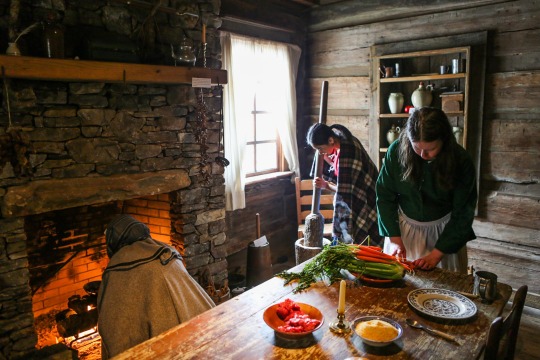

Marie Walker stokes the fire in the White Path Cabin

Diana Mancilla samples fresh bread from the “tavern”
Atlanta Historic Dance’s Kat Nagar taught guests a traditional folk dance called the Merry Merry Milkmaids.

Atlanta Historic Dance’s Kat Nagar
It was wonderful to see so many new folks and returning guests experience both our Family Day program and our exhibits. We also appreciate the new Google Reviews and Facebook Reviews we received after the event!
“Everyone was so friendly! We went for family day after the fun snow the day before. It was a cold day, but still many people showed up. We got lucky as the museum was open and free too. Normally there is an admission fee. Family day is the second Sunday of every month. My kids did a scavenger hunt, went through the exhibits, outside to the cabins, watched the live gun show, and enjoyed the family activities in the hall. The staff dressed up and were so fun and nice. My daughter enjoyed the lady who taught them a dance. We loved dressing up in clothes from the colonial times. Plenty of seating at their outdoor amphitheater. Exhibits have many interactive stations for kids. Our visit superceded my expectations. They have their own parking lot as well. Btw, I wasn't sure if they would be open because of the snow, so I sent a message on Instagram, not expecting a reply the day, but I got a reply in less than five minutes. I was over the moon. I was so hesitant to drive the hour while uncertain if they were going to be open or not, so that was a huge relief when I got a response! That's great representation!”
Leaving a review really does help us. If you haven’t reviewed us yet, please take a moment to do so at this link: Review the History Center

You can view even more photos and videos from this Family Day at the links below. We look forward to seeing you at our next Family Day, Women’s Work, on March 8th from 1-4 PM which will explore the work and influence of working women through 300 years of history.
Firing of the Flintlock Military Musket
Learning the Merry Merry Milkmaids Dance
Program Contextualization Clip
Photos from Family Day

Our free reading program, Gainesville Reads, has been in session since January and we are off to a great start! This program provides free one-on-one tutoring to students in 1st, 2nd, and 3rd grade who struggle with reading. All of our tutors are volunteers, many of whom are current or retired educators. We are so fortunate to have such supportive tutors in this program that excite students about reading. If you are interested in becoming a tutor, we do have two spots available for our 4-5 PM session and 6-7 PM session on Mondays. Email [email protected] if you are interested.
We are accepting new or gently used books for the program. If you would like to donate books, simply bring them to the History Center during our normal operating hours Tues-Sat 10 AM - 4 PM.
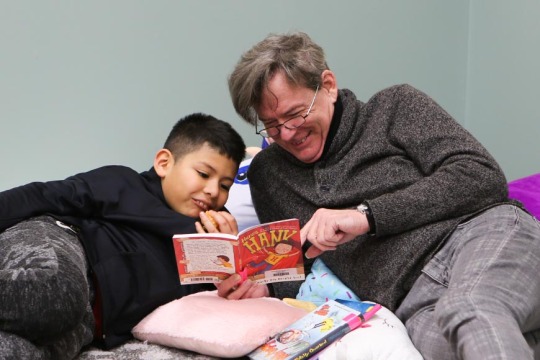

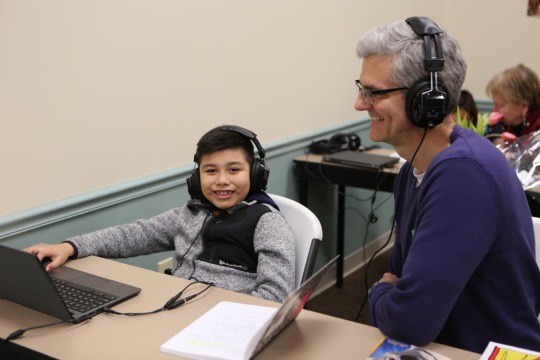


We want to thank the generous donors who made this program possible:
Mr. & Mrs. Tommy Bagwell, Mr. & Mrs. John Cleveland, Mrs. Linda Fowler, Mr. & Mrs. Jack Frost, Mr. & Mrs. Rusty Gravitt, Mr. David Haynes, Mr. & Mrs. Lorry Schrage, Dr. Margaret Schutte, Mr. & Mrs. Doug Tollett, Anonymous, Anonymous
We can’t wait to update you on the progress of our students when we celebrate their achievements in May!


By Museum Services Manager Brandon Cohran
The T.R.R. Cobb House in Athens, Georgia, sits on a side street in downtown Athens, but often draws interest from passersby due to its size and color – pink. Yes, pink is the original exterior color of the house! The house has a unique history all its own, but it is enhanced by the people who lived there too. Today, it is restored to reflect the styles and period from 1852-1862, the last ten years of Thomas Cobb’s life.

Image courtesy of T. R. R. Cobb House
In its earliest years, Thomas Reade Rootes Cobb, his wife Marion (daughter of Joseph Henry Lumpkin, the first Chief Justice on the Georgia Supreme Court), their four daughters, and their two sons who died in infancy, lived in the home. There were several enslaved persons who lived on the property as well, including Jesse, who Tom mentioned by name in several letters. T. R. R. Cobb, and his brother Howell Cobb, were both influential citizens in Athens during their lives, with T. R. R. being a lawyer, author, educator, slave owner, politician and Confederate Army Officer.

Portrait of T. R. R. Cobb
When the house was built in the mid-1830s it did not have its lavish front porch, in fact, the house was a different architectural style altogether – a plantation plain. The floorplan was a four over four, meaning four rooms on top of four rooms, and it stayed this way until the mid-1840s when two rooms were added on. By 1852, Thomas Cobb was wealthy enough to adopt more Greek revival architectural elements such as the two-story Doric columns, symmetrical octagon wings, and portico onto the front of the house. The floorboards in the octagon rooms are original!
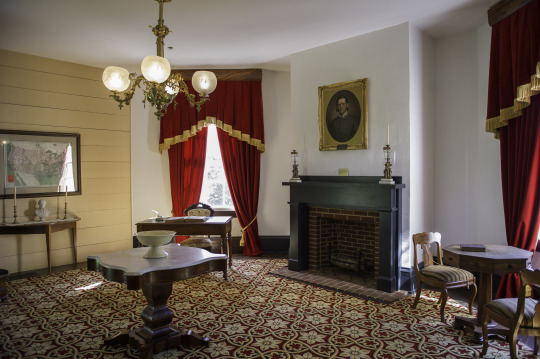
Image courtesy of T. R. R. Cobb House

Image courtesy of T. R. R. Cobb House
Once T. R. R. Cobb died in 1862 at the Battle of Fredericksburg, his wife Marion lived in the home until 1873 when it was sold. Once the Cobb Family was out of the house, it was a rental property, boarding house, and even a fraternity house before being purchased for use by the St. Joseph’s Catholic Church.
Today, the house sits about two blocks from where it originally did, because in the 1980s the house was moved 70 miles from Athens to Stone Mountain, Georgia, in lieu of being destroyed. It sat dormant at Stone Mountain Park for another twenty years before being moved back to Athens. Since the early 2000s, the Watson-Brown Foundation has worked to preserve, staff, and interpret the significance of the house and its inhabitants during the 19th century. The house operates today as a historic house museum and is open to the public for touring and features two exhibits.

Thank you to everyone who joined us for our Lunch & Learn program with President Abraham Lincoln! Director of Education Ken Johnston portrayed Lincoln and spoke about his life before and during his presidency. The audience had many questions for Lincoln including what his childhood was like, how he was educated, his views on slavery, and what it was like to live in the White House.

Our next Lunch & Learn will feature the story of George Shaw, a slave from Hall County who escaped to freedom by joining the US Navy. Join us on February 20th at noon!

This week From the Archives is a photograph from the TJ Allen and Sons in Harmony Grove, Georgia. Mr. Allen was a photographer in Harmony Grove, now the city of Commerce, from 1889 to 1919. After his 30-year career in North Georgia, he moved to a larger city to expand his business with his children.
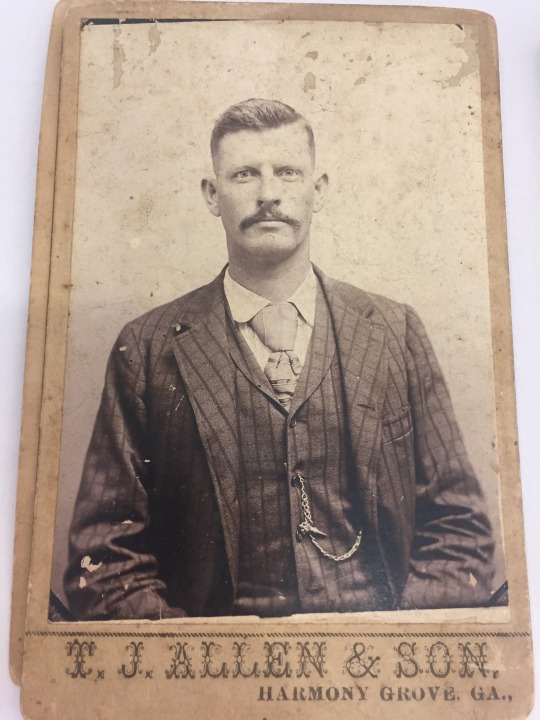
A portrait taken by TJ Allen
During his time in Harmony Grove, Mr. Allen also had the first handmade telephone in Jackson County; the line went from his photography studio to his home.
We have a few photographs from the TJ Allen and Sons company in our archives. This one is by far our most pristine, and although there is no identification for the gentlemen in the photograph, the name of the company helps us establish a time period and location for future research.

Lunch & Learn: The Story of George Shaw
Thursday, February 20th, 2020 from 12:00-12:45 PM
Included in General Admission
From Slavery on the banks of the Chattahoochee River to Freedom as a Sailor in the US Navy, Hall County native George Shaw’s life took quite a journey. Join us to hear about his odyssey and about African Americans in the Civil War Navies.
This event is included in admission. Feel free to bring your lunch as you enjoy the program!

Lunch & Learn: Girl Scouts Founder Juliette Gordon Low
Thursday, March 5th, 2020 from 12:00-12:45
Included in General Admission
Meet the Founder of Girl Scouts, Juliette Gordon Low (or "Daisy") during this Lunch & Learn! Daisy will tell the story of how she founded the Girl Scouts, stories from her childhood, her experiences around the world and more.

Family Day: Women’s Work
March 8th, 2020 from 1-4 PM
Free! Thanks to the Ada Mae Ivester Education Center
In conjunction with National Women’s History Month the History Center take a special look at the role of Women as they work at home and in public through close to 300 years of Georgia history.

Facebook
Instagram

Photograph of the Gainesville Railway Streetcar, 1903. Pictured are motorman John H. Lancaster and conductor Robert L. Gordan.
Source: https://dlg.usg.edu/record/hall_hchp_0352

Your donation of any amount makes it possible for us to offer outstanding programming to the community and preserve the precious artifacts we house. To donate, please visit: Make a Difference

0 notes